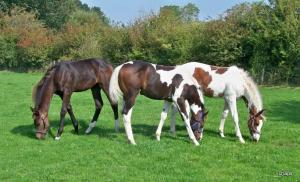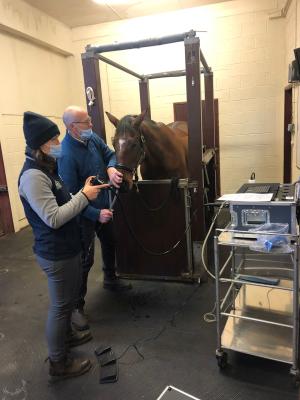
By Vet Freya Wood
Over the winter months we see many horses presenting for investigation for gastric ulcers. Gastric ulcers are classically associated with Thoroughbred racehorses in training, but we diagnose ulcers in all types of horses, from high and low level competition horses, pleasure horses and children’s ponies.
Investigation for gastric ulcers is often prompted by poor performance, with the horse being reluctant to go forward or poor behaviour when ridden. Other classic signs that may prompt an investigation for gastric ulcers are weight loss, recurrent colic, girthiness, and changes in behaviour that may include nervousness, aggression or self-mutilation. The signs of gastric ulcers can be very wide and varied from horse to horse.

The only way to diagnose gastric ulcers currently is by gastroscopy. There have been attempts to diagnose ulcers on faecal testing but there is no association between test results and presence of ulcers. Gastroscopy is performed under standing sedation, where an endoscope camera is passed down the nose, the oesophagus and into the stomach. This allows the whole stomach to be examined.
The stomach has two types of cell lining. Squamous cells cover the half closest to the oesophagus and this is a light pink colour (squamous mucosa). Glandular cells cover the half closest to the exit to the small intestine and this is a darker pink (glandular mucosa).
Under normal conditions, the glandular mucosa is exposed to the highly acidic stomach acid and therefore has defence mechanisms to protect the cells from acid damage. The squamous mucosa does not have the same level of protection and relies on the stomach always containing some roughage to buffer the acid. Squamous ulcers are associated with low roughage and high concentrate diets, stress, and limited access to water.

Squamous ulcers are graded from 0-4 based on the depth, size and number of lesions found. These are classically found on the border between the squamous and glandular mucosa, called the margo plicata, and the tight curve of the stomach called the lesser curvature. This grading allows an accurate comparison to be made over gastroscope examinations. Glandular ulcers have their appearance described rather than being assigned a numerical grade. There is such a wide range of presentations and there is no numerical grading system that has been validated as being both repeatable and an accurate representation of the severity of the ulcers.
The biggest challenge when finding ulcers is assigning a relevance to the ulcers. Some horses have tiny ulcers that they find extremely painful whereas many horses with extensive ulcers exhibit very few clinical signs. This presents a challenge when investigating poor performance or poor ridden behaviour as the ulcers need ruled out as a cause by treatment once found, before other avenues can be explored and their relevance determined.
Ulcers are treated with a combination of drugs. Omeprazole is the mainstay of treatment of squamous ulcers and is usually given as a paste daily on an empty stomach to coat the stomach lining. Glandular ulcers are treated with a combination of omeprazole and either sucralfate or more recently misoprostol.
Management is of utmost importance in horses with ulcers. Access to pasture should be maximised and horses should have constant access to water. Diet should be predominantly forage based, with as little grain feed as possible. Horses should not be fed any more than 2g per kg bodyweight of starch total per day. There are a number of ulcer friendly feeds on the market that contain the right balance of nutrients for a horse with ulcers, however, these will not resolve any ulcers present already.